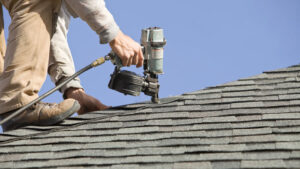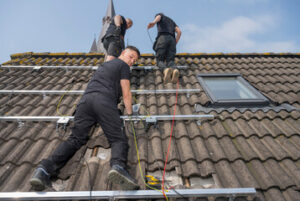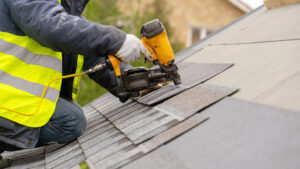Getting rid of unsightly algae and moss from the roof can help improve the overall look of your home. It can also protect your family from exposure to mold and can increase the value of your property. If you are comfortable working at heights and have a partner with you to hold the ladder and keep an eye on you, you can save money by cleaning your own roof.
High-pressure washing

Pressure washing is a popular Roof Cleaning Summerville SC technique, but it can be dangerous if not done properly. It can damage the surface of the roof and cause leaks in the structure of your home. If you’re going to try it yourself, make sure to follow the safety instructions on your pressure washer. Also, use a wide-angle nozzle to reduce the risk of damaging your roof. This nozzle will help distribute the force of the water evenly over the surface and avoid concentrated pressure points.
You can find commercial pressure washers that are designed specifically for roof cleaning. These cleaners use a combination of chemicals and low spray pressure to remove dirt, moss, and fungus from your roof. These cleaners will not only improve the look of your roof, but they will also prevent rot and help extend the life of your shingles.
High-pressure washing can be very dangerous and should only be used by professionals. It can damage shingles, cause leaks in the structure of your house, and damage your windows. It can also be expensive, as you may need to replace the damaged shingles.
A professional roof cleaner will use a combination of chemical cleaners and low spray pressure to clean your roof. This method is safer than traditional power washing and will also protect the integrity of your roof.
If you want to try this at home, be sure to wear gloves, goggles, and slip-resistant shoes. Also, make sure that you have a ladder that is stable. Start at the top of your roof and work your way down. Remember to rinse the detergent off your roof before you climb down. Wet shingles are incredibly slippery, so be careful not to fall.
A common problem that homeowners face is the buildup of black mold on their roofs. This can be a result of moisture and nutrient imbalance. If left unchecked, mold can spread to the rest of the house and damage its walls and foundations. It is important to keep the roof free of black mold to avoid costly repairs.
Low-pressure washing
Low-pressure washing is a gentler cleaning method that uses low water pressure to wash away dirt, grime, and other unwanted substances from your roof. It is a great alternative to high-pressure power washing, which can damage surfaces and structures around your home. It is also a safer option for most hard surfaces, including shingles, because it doesn’t use excessive force. In addition to using a lower pressure, this type of cleaning uses a special solution called a surfactant, which loosens, traps, and carries away dirt and other contaminants from your roof. It also helps reduce run off and ensures that the cleaner stays on your roof for longer periods of time, making it more effective.
In addition to a cleaning solution, low-pressure washing requires an additional chemical that kills any fungus or mildew that is growing on your roof. This helps prevent future growth and extends the life of your shingles. Moreover, it is more environmentally friendly than traditional pressure washing, because it doesn’t use bleach, chlorine, or lye.
Before you start the cleaning process, it’s important to make sure that all areas to be cleaned are free of debris and are safe for the clean. You should also check for problem areas that need more thorough cleaning and any loose shingles or spots that need to be repaired. Once you’ve done this, prepare your cleaning tools and ladders. Make sure that your ladder is secure, and step off of it before spraying. It’s also a good idea to wear protective eyewear.
While some companies advertise low-pressure washing, they may actually be using high pressure for the cleaning. This is often the case with gutter cleaning, where the company may use a pressure washer to clean your gutters and then rinse them off with a water hose. While this is fast and inexpensive, it can be damaging to your gutters, and it’s not the same as a professional low-pressure cleaning service. In contrast, a professional low-pressure cleaning company will adjust the pressure of the washing water to the surface that is being washed.
Chemical or non-pressure washes
This method is a fast and effective way to remove organic matter, such as mildew, mold, moss, and algae from roof tiles. It also leaves behind a protective film that prevents future mildew and moss growth. No-pressure chemical washes are also safer for delicate surfaces than high-pressure washing, as they do not produce water runoff. However, you should always test the surface for sensitivity before using chemicals.
Different cleaning chemicals are designed to tackle specific types of stains, so it’s important to know what kind of stain you’re trying to lift before choosing a chemical. The type of stain will determine what kind of pressure washer you need to use and the strength of the chemical you should choose. For example, bleach is a powerful alkaline cleaner that works well on organic stains but can damage certain materials. Citric acid, on the other hand, is a non-corrosive chemical that’s often used to clean concrete and wood.
When choosing a pressure washer for chemical cleaning, consider the PSI rating and the power of the pump. A higher PSI rating and more power are necessary for cleaning heavier dirt buildup and stubborn stains. You should also check the manufacturer’s recommendations and the environment regulations in your area. For example, many municipalities require that wastewater from a cleaning project be captured and diverted away from storm drains. This can require tarps, berms, and other precautions to protect the environment.
Low-pressure chemical washing uses biodegradable cleansers and moderate PSI levels to wash away black stains, grime, and other debris from the surface of the roof. It’s a safe and effective technique for most roofing materials, but it may not be suitable for extremely dark or heavily stained areas.
In addition, this type of cleaning is usually cheaper than high-pressure washing. It also doesn’t require the use of a spraying system, so you can save money on equipment and labor. Foam cleaning is also low-pressure and is great for textured surfaces that can be damaged by high water pressure. The foam clings to the textured surface, improving contact time and ensuring that all areas are covered. It’s also an eco-friendly choice, as it doesn’t use any toxic chemicals.
Brushing
A new roof is a wonderful addition to your home, but over time dirt, mildew and algae can make it look dingy. A regular cleaning can help restore a home’s curb appeal and keep it looking great.
There are many different ways to clean a roof, including high-pressure washing, chemical treatments and manual scrubbing. The best option is to hire a professional who uses environmentally friendly methods and products. This will save your landscaping and shingles from damage and will also protect the environment around your home.
High-pressure washing involves directing water at debris, mold, mildew and dirt to blast them away. However, this technique is not good for shingle roofs and can cause them to crack, curl or lose their adhesion. It can also damage metal roofs if it is used at too high a pressure. Additionally, it can damage plants and pollute waterways. It is also not recommended to use bleach on a roof, as it can discolor shingles and strip them of their protective oils.
Another popular method of roof cleaning is soft washing, which uses mild detergents and surfactants to loosen and wash away accumulated mud, sand and dirt. This method is gentle on the environment, and it is suitable for most roofing materials. It can be used on asphalt shingles, clay tile, and metal roofs.
Soft cleaning of your roof can also help prevent moss, lichen and algae growth. These organisms can discolor shingles and cause them to detach from the roof, which can lead to expensive repairs. Soft washing can also reduce sagging and other structural problems in older roofs.
All trees shed leaves, needles and cones, which can collect in the gutters and on the roof. Moss is a particular problem in the Pacific Northwest, where it likes to wedge between composition shingles, damaging shingle-to-shingle bonding and increasing the likelihood of shingles falling off during a windstorm. The removal of these organisms can improve the durability of a roof and increase its lifespan. In addition, a regularly cleaned roof can lower your energy bills.



